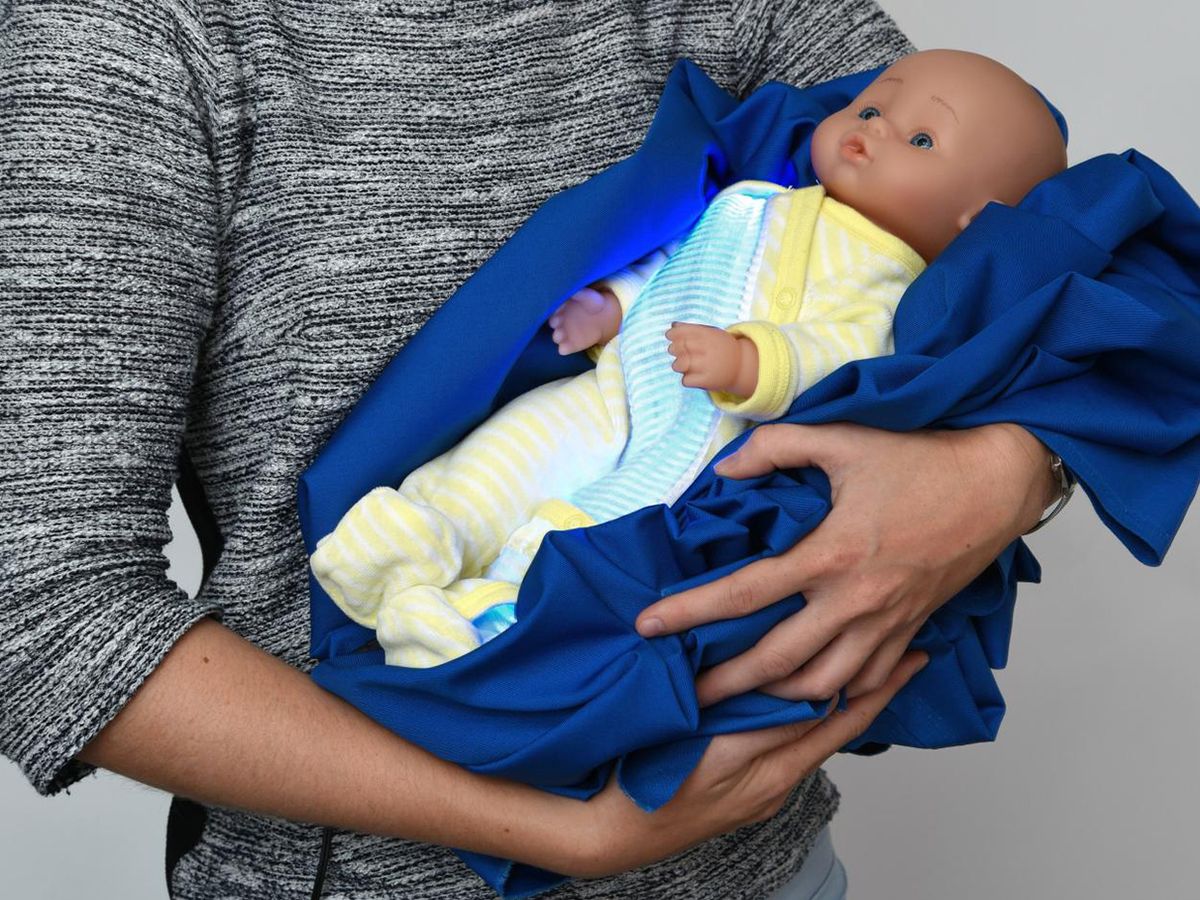Newborns being treated for jaundice must often lie naked under therapeutic blue light for hours at a time. New light-emitting pajamas could give parents a more comfortable, portable option for their babies.
Researchers at the Swiss Federal Laboratories for Materials Science and Technology, or Empa, in St. Gallen, Switzerland, developed the luminous fabric. They wove it with light-conducting threads, or optical fibers, tuned to give off just the right wavelength of therapeutic light. The researchers described their invention in the journal Biomedical Optics Express.

The key innovation was developing flexible polymer optical fibers that work in concert with textile manufacturing, says Maike Quandt, a researcher at the institute who helped create the textile. The fibers are yarn-sized and can be interwoven with conventional polyester threads. “We wanted to make it breathable and pliable so that it really feels like pajamas,” she says.
About 60 percent of babies are born with jaundice—a yellow tint to the skin and whites of the eyes. The color is a sign that the baby’s blood has too much bilirubin—a byproduct of the body replacing old red blood cells. The liver normally flushes bilirubin out of the body, but a newborns’ organ often can’t get the job done efficiently.
In some of those cases, the bilirubin levels get too high, and the baby must be treated with phototherapy. In this technique, the baby is placed in an incubator or light box that projects blue light. The light alters the chemical arrangement of the bilirubin, making it more soluble and easier to excrete through the gut and urine.
Such incubators are not the best place for a newborn to spend the first days of life. Babies wear only a diaper and protective eye patches to allow the rest of their skin to be exposed to the light. And the toughest part—they have to lie there alone for hours.
That’s particularly hard on parents, who, understandably, want to hold and nurse their new babies. “You need them as much as they need you,” says Julianna Hendrick, a new mother in Charlotte, North Carolina. Her son, now eight weeks old, had elevated bilirubin levels when he was born and needed phototherapy treatment. Nurses took him to a separate room at the hospital for treatment for “hours at a time,” Hendrick says, letting her hold or nurse him for just 10 minutes or so in between. “That was really hard. I would have really appreciated an alternative technology,” she says.
Hospitals sometimes use fiber-optic blankets such as GE’s BiliSoft Phototherapy System. But these blankets are stiff and have to be covered in plastic, because they can’t touch the skin directly. And they don’t get light to every part of the skin.
The Swiss researchers’ polymer optical fibers are weaved directly into the fabric of the pajamas, and don’t require a plastic cover. That makes them breathable and better able to emit light on all parts of the baby’s skin. The clothing also requires no post-production textile processing steps, like other luminous fabrics that developers have proposed in their prototypes.

Empa began to work on its polymer optical fibers in 2009 with other medical applications in mind, such as embroidered sensors that detect heart rate. The idea for applying the technology to phototherapy came from speaking with doctors at a nearby hospital, says Luciano Boesel, a researcher at Empa who led the project.
Light for phototherapeutic treatment must stay near a peak wavelength of 470 nanometers in the blue spectrum. To emit this light, Boesel and Quandt used a weaving process that bent the fibers at just the right angle around perpendicularly arranged polyester threads, producing a satin weave called a 6/6 bond. When connected to LEDs, this generated the right amount of light, emitting it throughout the fabric with constant intensity.
Boesel says he hopes to partner with a hospital next year to test the efficacy of the fabric on babies with jaundice. If those tests are successful, his institute plans to work with a manufacturing company to bring the textile to market, he says.
The product would join the many wearable baby technologies that have begun popping up on the market recently. Some of those products may prove more overwhelming than helpful to new parents. For example, the $250 Owlet Smart Sock, which monitors a sleeping baby’s pulse and blood oxygen levels, might cause needless false alarms.
Boesel says Empa will test its light-up pajamas in clinical trials and “work with industrial partners to develop a wearable medical device with performance equivalent to the ones used in hospitals.” The company would likely pursue regulatory clearance for the product, he says.
“It is very difficult to have wearables perform as good as real medical devices,” Boesel says. “That is the reason why most of them are still not certified” by regulators.
Emily Waltz is a features editor at Spectrum covering power and energy. Prior to joining the staff in January 2024, Emily spent 18 years as a freelance journalist covering biotechnology, primarily for the Nature research journals and Spectrum. Her work has also appeared in Scientific American, Discover, Outside, and the New York Times. Emily has a master's degree from Columbia University Graduate School of Journalism and an undergraduate degree from Vanderbilt University. With every word she writes, Emily strives to say something true and useful. She posts on Twitter/X @EmWaltz and her portfolio can be found on her website.



